Key takeaways:
- Selective mutism is an anxiety disorder that affects children, preventing them from communicating verbally in specific social situations, often leading to isolation.
- Signs include speaking freely at home but becoming silent in public, physical anxiety symptoms, and avoidance of speaking-required activities.
- Effective therapeutic approaches involve gradual exposure, cognitive-behavioral therapy, and play therapy to foster communication and build confidence.
- Building support systems, both in-person and online, is crucial for individuals with selective mutism to foster connection and validation in their experiences.
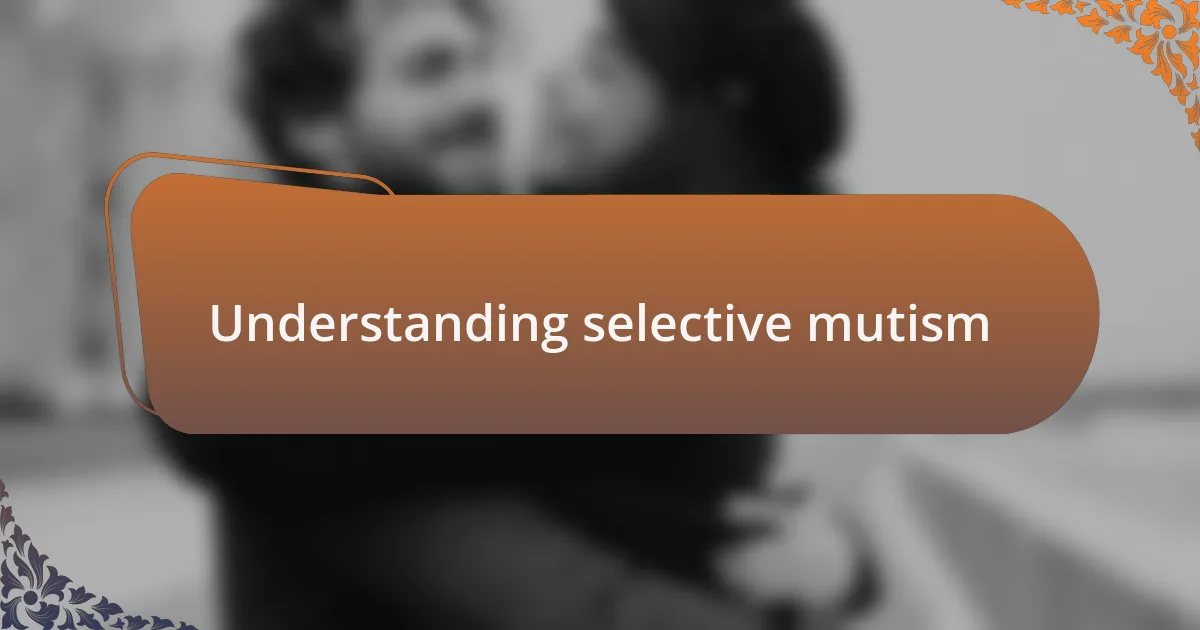
Understanding selective mutism
Selective mutism is much more than just shyness; it is a complex anxiety disorder that primarily affects children, causing them to struggle with verbal communication in specific social settings. I remember a friend whose daughter would light up at home but would freeze up completely in school, unable to speak even though she desperately wanted to connect with her classmates. Isn’t it heart-wrenching to see a child so eager to engage yet feeling trapped in silence?
This condition often emerges in early childhood when kids find themselves in overwhelming situations, making it difficult for them to express themselves verbally. It’s pivotal to understand that selective mutism is not a choice; rather, it’s rooted in deep emotional distress and anxiety. Have you ever felt that weight, where you know your voice is there, but the fear of judgment pulls it back? For many children, that fear manifests into a debilitating silence.
As I delve deeper into selective mutism, I can’t help but think of the importance of a supportive environment. Children thrive when they feel safe, understood, and accepted. I often reflect on how small, encouraging gestures, like gentle eye contact or a reassuring nod from a caregiver, can create a bridge over that vast chasm of anxiety. How can we ensure that children with selective mutism feel empowered to take that first step towards communication?
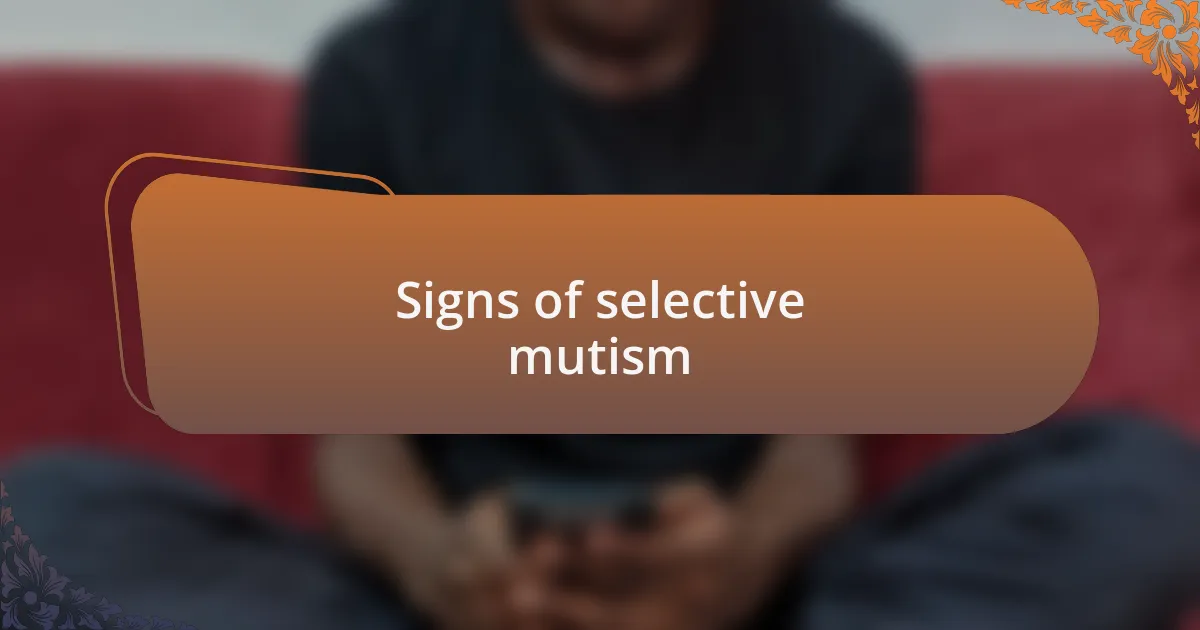
Signs of selective mutism
Understanding the signs of selective mutism can be challenging, especially since they don’t always appear obvious. Often, children who exhibit selective mutism may speak freely at home or in familiar environments, yet become entirely non-verbal in social situations like classrooms or playgrounds. I recall a boy I worked with who would eagerly recount stories to his family during dinner, only to sit silently during show-and-tell at school, desperately wanting to share yet feeling faceless among peers.
Another key sign is the presence of physical symptoms of anxiety that accompany the silence. These might include nervous habits like fidgeting, avoiding eye contact, or even trembling. I’ve seen children curl themselves into a ball when asked to speak in front of others, their bodies signaling the internal struggle. It’s heartbreaking to watch someone so vibrant retreat into themselves, isn’t it?
Finally, a notable sign is the reluctance or refusal to engage in activities where speaking may be required, often leading to avoidance of certain social situations altogether. For instance, a child may refuse playdates or extracurricular activities due to their fear of speaking up. As I think about these signs, it reinforces the necessity for awareness and support for both the child and their caregivers—so they don’t navigate this daunting journey alone.
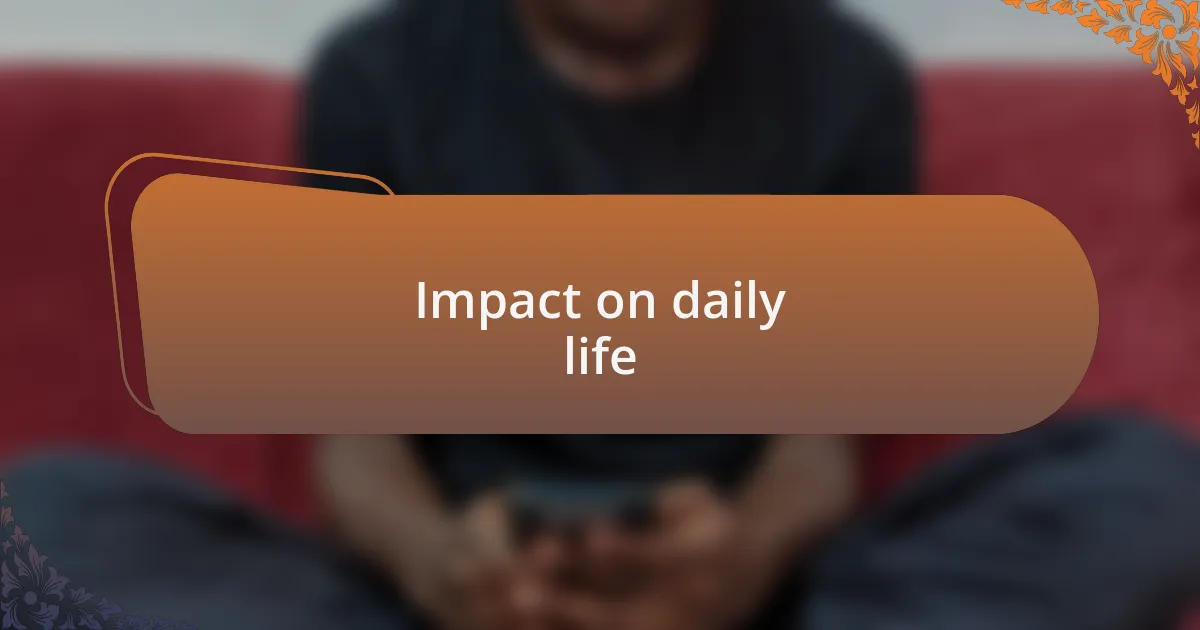
Impact on daily life
Daily life for someone with selective mutism can be an uphill battle. Take, for example, the experience of a typical morning routine. A child might feel anxious even just thinking about going to school, where the pressure to speak can feel suffocating. I remember a parent sharing how her daughter would hide in the bathroom, paralyzed by the thought of answering questions from her teacher, missing out on a world of connection because of her fear.
Social gatherings pose another significant challenge. Imagine a birthday party filled with laughter and joy, yet one child sits quietly in the corner, longing to join but feeling trapped in silence. One friend of mine reflected on how her son missed out on developing friendships because he felt unable to express himself in group settings. It’s a poignant reminder that while life can seem so vibrant, it may also feel isolating for those struggling with selective mutism.
The impact on daily life extends beyond the individual; it affects families and relationships too. I once spoke with a mother who described her frustration and helplessness when her daughter would clam up during family outings. She often wondered, “What can I do to help her feel safe enough to speak?” This is the reality for many families navigating the complexities of selective mutism, where each unspoken word can feel like a missed opportunity for connection.

Effective therapeutic approaches
Effective therapeutic approaches can create a safe space for children grappling with selective mutism, fostering the courage to express themselves. One method that resonates with me is gradual exposure. I recall a therapist who worked with a young girl, starting with simple non-verbal communication like nodding or shaking her head. This gentle introduction built trust, easing her into more vocal interactions over time. Isn’t it fascinating how small steps can lead to monumental changes?
Cognitive-behavioral therapy (CBT) is another powerful tool in addressing selective mutism. It focuses on reshaping negative thoughts, which often paralyze children into silence. I once met a boy who had learned to identify his anxious thoughts before speaking. With the help of his therapist, he transformed those doubts into positive affirmations. It was heartwarming to witness how his newfound mindset helped him speak up in class, demonstrating that our thoughts can indeed shape our reality.
Lastly, integrating play therapy can significantly enhance communication skills in therapy. I had the chance to observe a session where a therapist used storytelling as a medium. The child was encouraged to create narratives, expressing themselves through characters rather than direct dialogue. It opened a pathway for communication that felt less intimidating, allowing for spontaneous expression. How remarkable that through play, kids can unlock their voices and connect with the world around them, wouldn’t you agree?
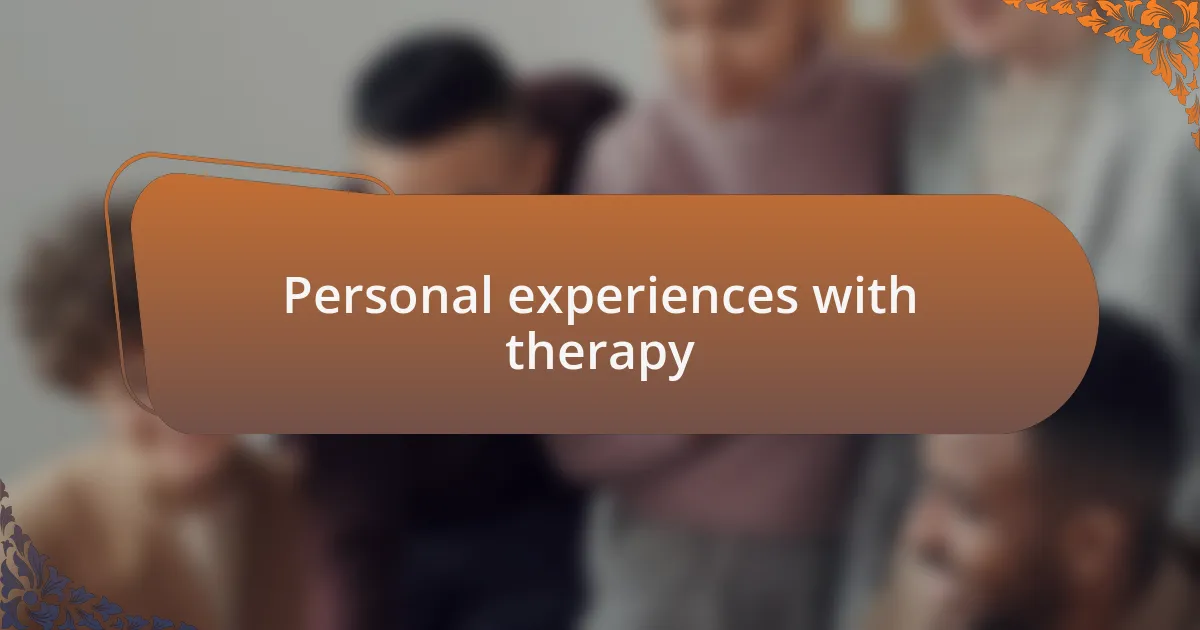
Personal experiences with therapy
I remember my first experience with therapy, feeling a rush of nerves as I sat in that unfamiliar room. The therapist started by simply listening, and it amazed me how the act of sharing my thoughts made me feel a little lighter. It was as if each word I spoke chipped away at the silence that had confined me for so long. Have you ever felt that relief when you finally reveal what’s been weighing on you?
One memorable technique my therapist employed involved role-playing. I found myself in character, stepping away from my own anxieties to portray someone else entirely. It was an unconventional experience, but being someone else momentarily allowed me to express thoughts that I struggled to voice as myself. Did you know that sometimes stepping outside your own shoes can offer a new perspective on your struggles?
Over time, I discovered that journaling played a crucial role in my therapy journey. Writing down my feelings transformed them from abstract fears into tangible words on a page. I often reflected on my sessions, and this practice let me see my growth over time—transforming fear into a roadmap for progress. Isn’t it incredible how ink and paper can give shape to our innermost thoughts, making them more manageable?
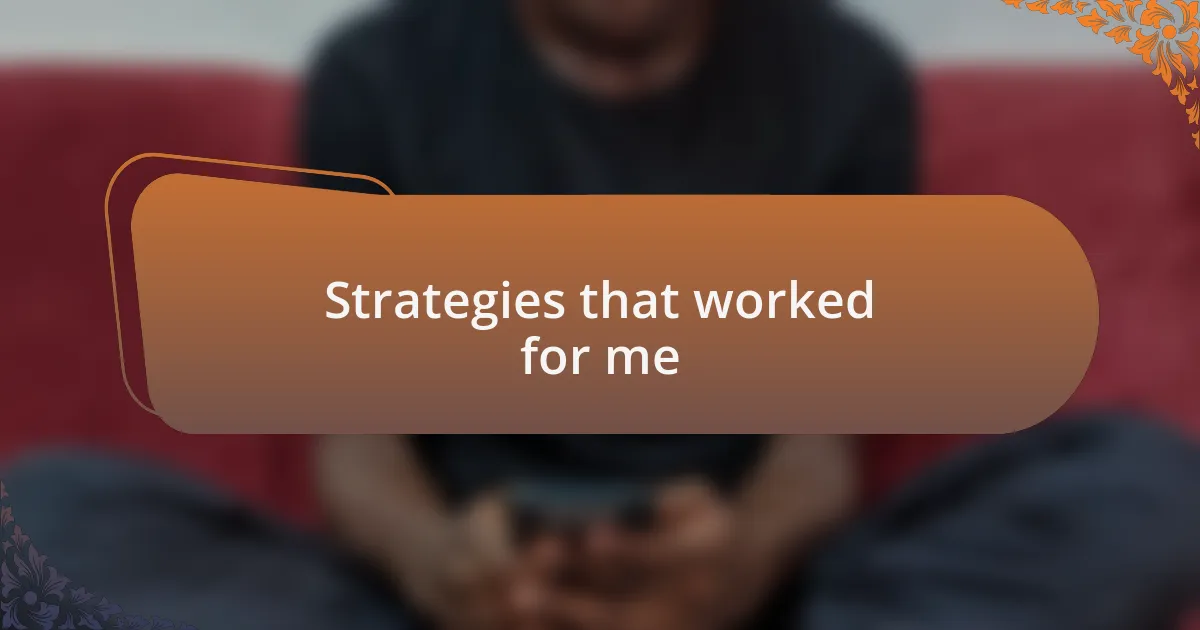
Strategies that worked for me
One strategy that resonated deeply with me was practicing deep breathing exercises before speaking. I vividly remember feeling my heart race in social situations. Focusing on my breath shifted my attention away from the pressure to perform, grounding me in the moment. Have you ever noticed how a simple breath can transform your mindset?
Another effective technique involved finding a supportive buddy, someone I could trust to share my thoughts with beyond therapy sessions. This person would gently encourage me to speak in low-pressure environments, creating safe spaces where I felt comfortable expressing myself. Reflecting on those interactions, I realize how crucial it was to have someone cheering me on, validating my efforts—don’t you think that a little encouragement can make a world of difference?
Lastly, I discovered the power of positive affirmations. Writing simple phrases like “I am capable of speaking” and reciting them daily helped reshape my internal dialogue. The shift in my self-perception was profound; with each affirmation, I felt a growing sense of agency over my voice. Have you tried telling yourself something positive and felt the change it brings?
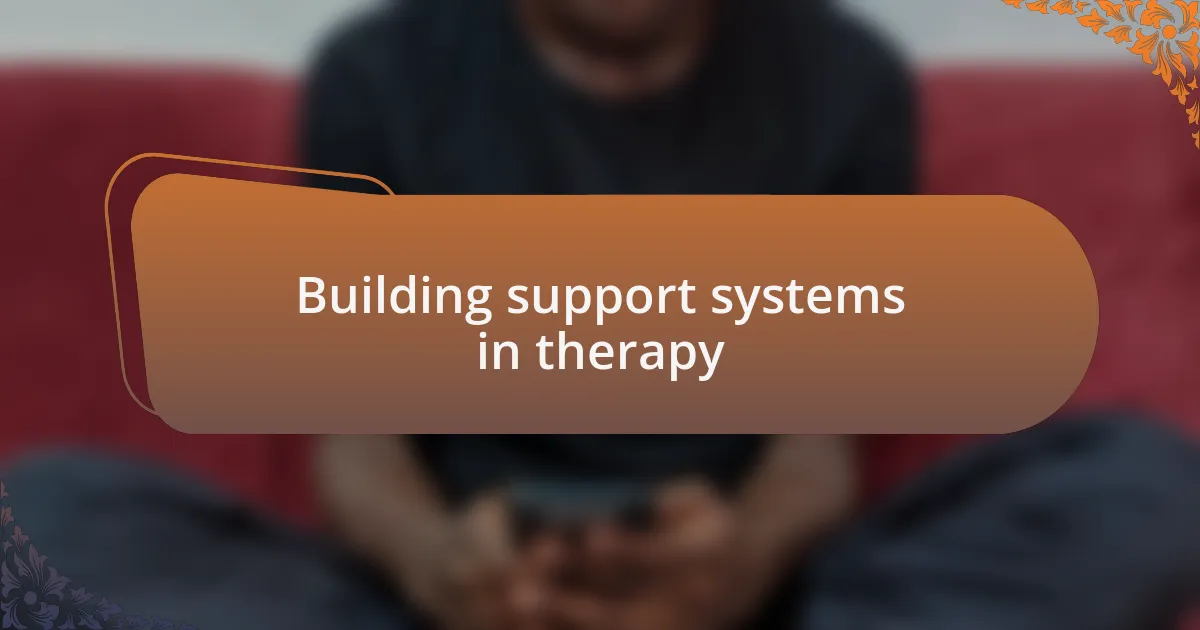
Building support systems in therapy
Building a support system in therapy can be transformative. I recall introducing my therapist to my family during a session. It was nerve-wracking, but their understanding of my journey opened a channel of communication that was previously stifled. Have you ever had a moment where introducing your world to someone else changed the narrative?
Creating a network of supportive friends also played a significant role for me. I organized informal meetups where we shared not just laughter but also our struggles with selective mutism. Those gatherings weren’t just about breaking the silence; they became a safe haven where I could articulate my experiences without judgment. Can you imagine how liberating it feels to be truly heard among friends?
I found that online communities can extend that support beyond geographical limits. Participating in forums allowed me to connect with others who understood what I was going through. Sharing stories and coping strategies in this digital space gave me strength and validation that I needed during difficult times. Have you explored any online groups that resonate with your experiences?